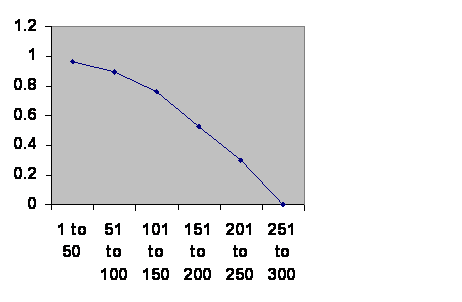April 12, 2010
Nicholas Eberstadt PhD
American Enterprise Institute
1150 Seventeenth Street, N.W.
Washington, DC 20036
202-862-5825
eberstadt@aei.org
Dear Dr. Eberstadt:
I appreciated your contribution to the documentary “Demographic Winter.” To start out off the point, you said that people aged 30 to 44 are the innovators. I hope that is the rule and not the law because I have a very important innovation. I was cudgeling my brain about why civilizations fail and the question came to me, “Well how long do they last, anyway?” I pulled out some dates from the longest history available, Mesopotamia, and started grinding. It took some time to get in into this form, but this is what I found:

Information taken from R. H. Carling THE WORLD HISTORY CHART International Timeline Inc. Vienna, VA 1985. The experience of Southern Mesopotamia. The vertical axis is The chance of an empire of any age continuing to rule locally for another 50 years. The horizontal axis is the ages of the empires. I broke the Ottoman Empire into two, because their Janissary elite came from two different sources during the early and late empire.
Suddenly I was alone on a strange planet. Societies fail by a harsh mathematical law. Heroics, wisdom, folly, luck, economics, and wealth may be important but they are invisible in the big picture. There is only one cause. If we failed for internal reasons like bad leaders, the line should go up as those societies able to produce good leaders demonstrated their strength and on average had a greater life expectancy. If we failed for external reasons like climate change, it would have nothing to do with the age of the society, and the line would be horizontal. But it goes down. The only possible explanation is genetic. The big gene pool goes infertile over multiple generations and there are not enough capable people to go on. Demographics is destiny.
One may gaze in horror at the antics of North Korea, but they will not collapse for internal reasons. So long as the inner cadre has a birth rate that will produce capable leaders (yes, I understand you may take issue with the word “capable” but the results of truly incapable leadership are horror of the worst order) they will muddle through. But their time must ultimately run out. Unless they have a rational mating strategy, their fertility will fail. Then comes the deluge.
You can dismiss my data as a fluke. But there is a mass of other data pointing in the same direction at nobabies.net along with my letters and other material. I would suggest looking at the March 25, 2010 entry first.
I understand that a case can be made that people have the family size they want. Talk with them and they will assure you it is true. But at Harvard Medical School we were posed the question, “Which is worse, to lose one child out of four or to lose an only child.” The answer was that children are not tires. You don’t have a spare. Each tragedy is as bad as the other. So family size, at least according to the good professor, does not mean anything. What matter are family members.
This may be part of the paradox. The world is facing an unthinkable catastrophe of infertility but people accept it with a shrug. They don’t miss children they never had. Hence the importance of documentaries like “Demographic Winter.”
You offer environmental consciousness as a reason not to have children. Maybe so, but people seem to be pretty tranquil about what they are doing to the environment most of the time. They won’t recycle plastic bags unless goaded. It would be surprising if they worried about the environment while having babies.
In fact the grim statistics in the graph (and as I said a lot more besides) suggest that we are in far greater danger from Mother Nature through infertility than through any of the other extinctions she could visit upon us.
Have a look at the data and let me know what you think.
Sincerely,
M. Linton Herbert MD
There have been 3,853 visitors so far.
Home page.
